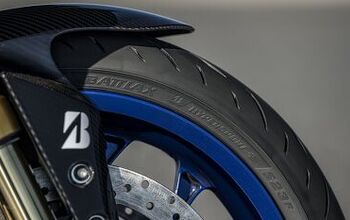Sit Up or Lay Down? - Motorcycle.com
The most frequently asked question of a motojournalist, besides "Who do you know that can pick you up at the hospital?" is "which motorcycle do you think I should buy?", as a sensible person would assume a motojournalist would have a lot of experience with a lot of different bikes. This is actually not an easy question to answer for one of us- we like almost everything we ride, and the memories of purchasing a motorcycle with our own money becomes dimmer with every passing month. More importantly, we don't know what your skill level, tastes, or specific needs are for a motorcycle.
A better question would be "what motorcycle would you want if you could only have one bike?" This is a question we're better equipped to answer, as the garage at any given magazine usually has a number of bikes in it available for staffers to ride.
This test attempts to answer questions that would go past just choosing between an R1 and an FZ-1, because only a small percentage of potential motorcycle buyers would be making a decision like that. However, many motorcyclists probably agonize over buying a standard machine like the FZ-1 over buying a flashier, faster, lighter, and more expensive sport or supersport bike.
Which machine goes faster in a straight line? Which machine is more fun on a twisty road? Which machine does better as a commuter or carrying a passenger? Which would be a better choice for a trackday?
Each of these staffers spent as much time as he needed on these two bikes, and then submitted notes on his impressions of the two machines. We then ranked the bikes by how often they were selected as favorite, and picked an overall winner. But before we tell you about what they were like for each evaluator to ride, let's cover the basics of each bike.
The FZ-1 is a heavyweight standard motorcycle with a tube-steel chassis and the fearsome, 1,000 cubic centimeter four cylinder liquid cooled engine from Yamaha's first generation YZF-R1 sportbike. The engine is tuned for midrange power, but still produces about the same rear-wheel horsepower as the 1998 R1 did: 128, which was a fearsome number back in those halcyon days, and unless you're Mat Mladin, is more power than any sensible person needs for street riding.
The R1, on the other hand is all business. The current iteration was introduced in February 2004 and is the third generation of R1s- some of the most memorable, earth-shattering Japanese sportbike designs of the last 20 years. It is one of the best open-classers around, and lost by a smidge at last year's open class shootout. As the R1 is designed to have the best combination of power, handling and light weight, there are fewer concessions to street comfort. The 2005 R1, unchanged from 2004, uses a massive, yet light twin-spar "deltabox" chassis, huge swingarm, and inverted 43 mm cartridge fork to keep the 153 horsepower engine going in a straight line. All this technology gets wrapped up in a package that weighs in at a *claimed* dry weight of 379 pounds. Since little expense is spared making a liter-bike weigh what a race-replica 600 would have weighed five years ago, the R1 will set you back $10,999 or $11,099 in the very cool Black Raven paint scheme.
Both motors displace 998 cubic centimeters and breathe through 20 valve cylinder heads. The FZ-1 shares an obvious common ancestor with the R1, but after the rider experiences the crazed liter-bike power the similarities run short. Even the motor isn't really that similar; the FZ-1 uses a slightly longer stroke and smaller bore, where the R1 has a larger bore and shorter stroke, helping it achieve its power peak at a much higher 13,750 RPM. Also, the FZ-1 still uses 37 millimeter CV carburetors, albeit with a throttle position sensor, where the R1 uses fuel injection to send fuel to the engine. With almost six years of refinement and R&D, it's easy to see how Yamaha's engineers could manage another 27 horsepower out of the same sized engine.
Along with everything else about the bike, the R1's gearbox feels just that slight bit tighter than the FZ-1's. This helps to contribute to the R1's overall impression of solid purpose. However, the FZ-1 shifts quite well and neither bike missed a shift or behaved poorly in the powertrain department.
Comfort is a big concern for most riders, especially if they are limited by self-centered spouses to just one motorcycle. Predictably, the FZ-1 has the edge in the cushy category, although the R1 has some surprises in store.
Ergonomics on the R1 are typical modern supersport and feel a little cramped at first, but after a solid day of riding, Publisher Alexander still felt fresh after riding the R1. For the 2004-2005 model, the footpegs have been moved down 7mm and forward 2.5mm from the 2002-2003 R1 and the clip-ons have been raised 10mm. Coupled with a narrower, redesigned frame this results in a roomier riding position.
However, this seems like a night in a Turkish prison compared to the couch-like (make that Ottoman-like) FZ-1. In addition to the obvious comfort advantage of the tall, wide, superbike-styled handlebar, the FZ-1 holds another big edge over the R1 in its extra carrying capacity. It has much larger, less frightening and more comfortable passenger accommodations, in addition to plenty of room for soft luggage. The R1's unfortunate passenger has to hunch forward and hang-on for dear life, while perched way up there above the rider's back. We're sure you could tour on an R1, but that would be like using a Mazda Miata to help your friend move.
Riding around town, the FZ-1 showed its civility and was popular with our testers. There's no doubt it's much more comfortable than the R1 around town, as the FZ-1 is easier and more accessible to ride. That is due to the upright riding position, lower first gear and high-leverage handlebars. The FZ-1 feels the way UJM's should have felt in the 70's: solid and wicked fast in traffic while delivering all-day riding comfort to the kind of riders who purposely miss their freeway exit.
The FZ-1 is at a bit of a disadvantage around town. Heads-up no-warning no-downshifting roll-on drag races favor the R1, even though the FZ-1 has shorter gearing and a motor that's "tuned-for-torque". If the R1 rider has a second to prepare themselves, the FZ-1 doesn't even have a chance. Of course, this shouldn't come as a surprise: the R1 has an extra 25+ horsepower and carries significantly less weight.
But if that was the case, you'd be reading a review for something else. If you are in the market for a high-performance streetbike, you probably want to know how it will perform when you are in the Zen-like state that comes when you are late-braking into your favorite corner. And here, there was no ambiguity on the part of our testers. The R1, to nobody's surprise, was a clear winner here.
More by MO Staff



































Comments
Join the conversation